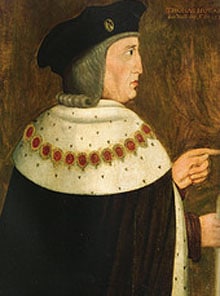
Now, that I have finished my series on Henry VIII and his change from virtuous prince to tyrant, I thought it would be good to look at the Boleyn family. Today’s post is on Elizabeth Boleyn (née Howard) and is a guest post from Anne Boleyn Files visitor Sheena Reekie – thanks Sheena!
Elizabeth Boleyn
by Sheena Reekie
There are many people in history whose stories have been lost in time. Although we know about the exploits of Thomas, Mary, George, and Anne Boleyn, by all accounts little is known about the wife and mother of the infamous Boleyn family. How did she feel about her daughter Mary’s reputation? Did she support Anne’s relationship with Henry VIII? Did she watch her children’s executions at the Tower? What happened to her in the aftermath of the scandal that ruined her family? Just who was Elizabeth Boleyn?
Background and childhood
Elizabeth Howard was born sometime between 1480-1486 at Arundel Castle in Sussex. She was the eldest daughter of Thomas Howard, 2nd Duke of Norfolk, by his first wife Elizabeth Tilney. Through her father, she was a direct descendant of King Edward I1. Despite being a member of the prestigious Howard family, there is surprisingly very little known about Elizabeth.
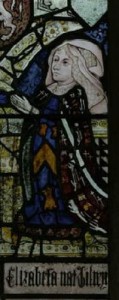
After the defeat of King Richard III (who was killed at the Battle of Bosworth and supplanted by Henry VII), the Howard family gained favor with the new monarch and had their titles restored to them in 1514. As was typical of noble families, when Elizabeth was a young girl, she was sent to court to serve in the household of Elizabeth of York.
Life at court
After the death of Henry VII, Elizabeth remained in the royal household and began serving as lady-in-waiting to Catherine of Aragon. Historically recorded as being an attractive woman2, rumors circulated that Henry VIII once had a dalliance with Elizabeth Boleyn after he came to the throne3. Many historians tend to discount this claim due to the fact that Henry did not mention any affair with Elizabeth when he filed for his dispensation to make his marriage to Anne lawful. When it was claimed that Henry had had an affair with both Anne’s sister and mother, the king is said to have replied to the rumors, “Never with the mother.” Elizabeth did, however, catch the eye of an ambitious member of court by the name of Thomas Boleyn.
Wife and mother
Sometime between 1498-14994, Elizabeth wed Thomas, a young courtier and diplomat who was also serving in the court of Henry VII. Through their union, Elizabeth gained the titles of Countess of Ormond and Viscountess Rochford5.
According to the writings of Thomas Boleyn, Elizabeth was pregnant many times in the first few years of their marriage. It is believed that she had 5 pregnancies, of which 3 of her children (Mary, George, and Anne) survived to adulthood.
Between 1518-1521, the Boleyns were living in France, where Thomas was serving as English ambassador. It is at this time that her daughters, Mary and Anne were serving in the French court as ladies-in-waiting to Queen Claude.
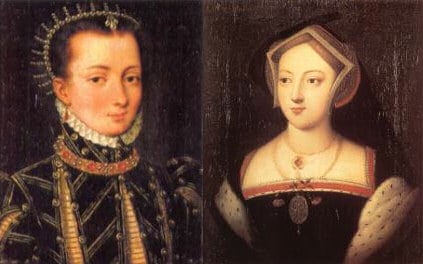
According to historian M.L. Bruce, both Thomas and Elizabeth developed “feelings of dislike” for their daughter Mary in the wake of her affair with King Francis of France. Later, the papal nuncio in France, would record that the French monarch had referred to Mary as, “my English mare”; and later in his life described her as “a great wh*re, the most infamous of all6. In the attempt to clear her name, Thomas and Elizabeth arranged a marriage between Mary and Sir William Carey, a court courier and favorite of Henry VIII7. This would later backfire, as Mary would become mistress to Henry VIII. After the death of her first husband, Mary eloped with commoner, William Stafford, in 1535. Elizabeth Boleyn sided with the rest of the family and banished Mary from court for breaching royal etiquette8.
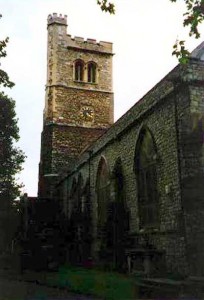
As opposed to Mary, Anne enjoyed a close relationship with her mother. Elizabeth had been in charge of her children’s early education and is said to have taught music and religion, reading, writing, and embroidery, of which Anne embraced9. When Anne began her relationship with Henry, it was Elizabeth who accompanied Anne to court, and kept a watchful eye on her daughter. She would remain a part of Anne’s royal household and is even believed to be the namesake of Anne and Henry’s daughter, the future Queen Elizabeth I.
The Fall of Anne Boleyn
It is unknown how Elizabeth felt in the wake of the scandal that would lead to the execution of two of her children, the stripping of her husband’s titles, and the bastardization of her grand-daughter. It is also unknown if she witnessed their beheadings. What is known is that she quietly retired to the English countryside, and died April 3, 1538 at Abbot of Readings place, Baynard’s Castle. She is buried in the Howard Family Chapel at St. Mary’s in Lambeth Cemetery.
Controversies of Elizabeth Boleyn
- She did not die in 1538, she died in 1512 – It is probable that this inaccuracy was run as fact in earlier biographies by authors like Agnes Strickland (Lives of the Queens of England- 1840-1848) and Hester Chapman (Challenge of Anne Boleyn -1974). Henry Howard (a later relative) printed the “Howard Memorials” in 1834 and lists Elizabeth’s death in 1512 from complications due to childbirth. It is possible that he confused this with her sister, Lady Muriel Howard, who was married to Sir Thomas Knyvett and really did die in childbirth in 1512. Her Oxford Dictionary of National Biography entry is 3 April 1538.
- Thomas Boleyn remarried which is why there is no direct reference to his wife, “Elizabeth”
-If Elizabeth had died in 1512, it would be highly unlikely that Thomas Boleyn’s second wife would have been of lower birth, considering that he was in favor with Henry VIII in 1512 (in 1512, he was one in a part of 3 envoys to the Netherlands). Also, nobles would have been called by their titles, so if there was reference to Elizabeth, it would have been by the title, “Countess of Ormond” or “Viscountess Rochford.” - She was one of Henry VIII’s mistresses – As stated earlier, Henry never made mention of having relations with Elizabeth Boleyn when he petitioned for his papal dispensation to marry Anne. It is possible that Elizabeth Boleyn is being confused with Elizabeth Blount, who if officially recognized as one of Henry VIII’s mistresses. There is belief that this rumor was started in the wake of the fall of the Boleyns to bring more shame upon their family.
- Thomas and Elizabeth did not have a happy marriage – It was typical of women of the time to be buried with their husbands. In the aftermath of the annihilation of her family, it is quite possible that there was a falling out between Elizabeth and Thomas. This would explain why she is buried in the Howard family tomb vice in the Boleyn family tomb.
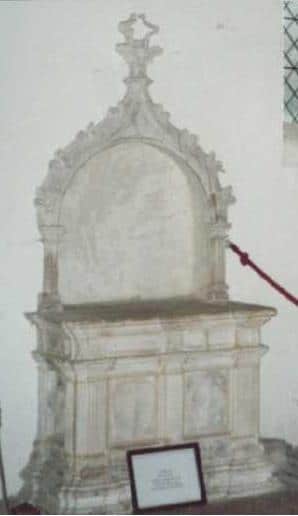
Notes and Sources
- “The Six Wives of Henry VIII”, by Antonia Fraser, p. 116 (1992).
- “Anne Boleyn,” by Marie-Louise Bruce, p. 13 (1972).
- “The Mistresses of Henry VIII” by Kelly Hart, p.118 (2009)
- “The Life and Death of Anne Boleyn”, by Eric Ives, p.17 (2004).
- “Henry VII”, by Stanley Bertram Chrimes, pg 138 (1999)
- “Anne Boleyn,” by Marie-Louise Bruce, p. 23 (1982).
- “Henry VIII: The King and His Court” by Allison Weir, p. 216.(2001)
- “The Six Wives of Henry VIII,” by Alison Weir, p. 273 (1991).
- “The Six Wives of Henry VIII,” by Alison Weir, p. 148 (1991).
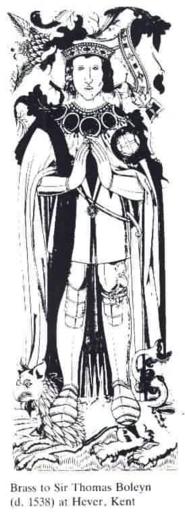
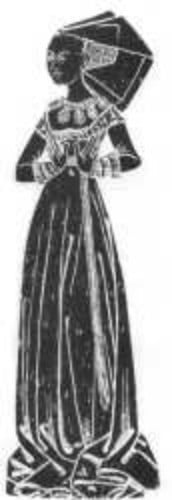
I really love to learn more about Anne’s family!! Her mother is indeed a mystery, we just don’t know enough about her. Thanks Sheena and Claire!!
I think you will find that the picture you have used here is of the tomb of a child called Elizabeth Howard, a daughter of the fourth Duke of Norfolk, not the Elizabeth Howard who was Anne Boleyn’s mother. This tomb is in St Michael’s Church, Framlingham in Suffolk, whereas Elizabeth Boleyn is buried in the church of St. Mary-at-Lambeth, which is now deconsecrated and used as The Museum of Garden History.
The other picture “unknown lady” is clearly not a portrait of Elizabeth Howard, or at least not a portrait done in her lifetime – the clothes and hair are totally wrong, about 70 years out by my reckoning. The portrait does not in fact look like an English one at all to me, it more closely resembles portraits I have seen of Spanish nobility of the later C16th.
Good article!
The confusion regarding the date of her death is odd given that other Victorian writers, namely Mary Anne Everett Wood in her letters of royal and illustrious ladies series, stated quite clearly that Elizabeth died in 1538. Why this was overlooked by other historians of the age is odd – seems some didn’t do their research properly!
Just to add – Elizabeth’s half sister, Katherine, served as the chief mourner at her funeral. Interestingly Chapuys recorded in 1531 that Katherine and her then husband Sir Rhys ap Gruffudd, were unfavourable towards Anne Boleyn and he tried to blame her for Sir Rhys’s execution that occurred in the same year. Despite this, Katherine showed no indication of resentment towards her niece in contemporary letters; in fact she naturally sought to exploit her ties to her. Katherine seems to have been inclined to conservative practices and she had links to Thomas More, though this did not obstruct her relationship with either her niece or her half sister.
I always found Anne’s concerns over her mother’s welfare voiced during her imprisonment in the Tower to be quite telling. Cleary she was worried about how her mother would cope and seems to have exhibited far more concern for her mother (and her brother) than for herself in those gloomy days.
Do you recall in what letter the data about Elizabeth’s funeral is mentioned? Please send it to my e-mail if you do!
See notes on p121 of the online version of Mary Anne Everett Wood’s collection of letters at http://www.archive.org/stream/lettersroyaland00greegoog#page/n140/mode/2up/ on the letter from Lady Catherine Daubeney to Secretary Cromwell where it states that “her ladyship was one of the chief mourners at the funeral of the Countess of Wiltshire” and gives the reference Husee to Lady Lisle, Lisle Papers vol. xii fol. 39
I looked up Husee’s letter in Letters and Papers and he wrote to Lady Lisle on 9th April, saying:-
“My lady Wiltshire was buried at Lamehithe on the 7th. My lord Comptroller was chief mourner of the men and lady Dawbny of the women. She was conveyed from a house beside Baynard’s Castle by barge to Lambeth with torches burning and four baneys (banners?) set out of all quarters of the barge, which was covered with black and a white cross. At her burial was the King of Heralds, a herald, and a pursuivant. The King lies now at the Master of the Horse’s and comes on Friday to Greenwich. Mrs. Whalley gapes for a piece of wine. London, 9 April.” LP xiii part 1 717, see http://www.british-history.ac.uk/report.aspx?compid=75765
Also see http://www.archive.org/stream/lettersroyaland02greegoog#page/n70/mode/2up You need to look at the notes accompanying the letter from Lady Frances Basset to Lady Lisle, p58 where it states that Elizabeth Boleyn died on the 3rd April 1538. I checked this reference too in L&P and found Thomas Warley’s letter to Lady Lisle dated 7th April which said:-
“My lady of Wiltshire died on Wednesday last beside Baynard’s castle.” LP xiii. part 1 696
Wow, too bad there is no more information on this lady – the first major female influence on Anne.
Anne’s later inspirations were very strong, intelligent, powerful and influential women – Margaret of Austria, Louise of Savoy, Marguerite of Alencon and later Navarre – so it is hard to imagine that Lady Elizabeth would have fallen short on any of those accounts, especially given Anne’s closeness with her mother during the “Great Matter.”
The double standards of history tick me off, anyway. So many interesting women, deserving of attention, were ignored in favor of the men.
i always wondered about annes mother, there isnt much written on her in the books i have read. thanks for the article, i love when rumours are dismissed!
It was interesting to hear that Anne had a close relationship with her mother, it sheds light on her own role as a mother to Elizabeth I.
Marilyn, thanks for clarifying that the picture of the tomb of Elizabeth Howard was in St. Michael’s Church, Framlingham, Suffolk, not in St. Mary-at-Lambeth. I visited the Museum of Garden History several years ago, not because I’m a keen gardener (which is what I was asked the minute I walked in the door), but because I wanted to see the Howard Aisle since I heard that Anne’s mother was buried there. I didn’t remember seeing a tomb for her there; in fact, I had to ask one of the people working in the museum where the Howard Aisle was. I’ve also visited St. Michael’s Church, Framlingham, and would highly recommend it to anyone interested in the Howards or Tudor England in general. There are several tombs of the Howards in the chancel, including Thomas Howard, 3rd Duke of Norfolk, who managed to escape the executioner’s axe due to the fact that Henry VIII died the night before he was due to be executed. Thomas Howard managed to live to be over 80 and died in his bed, despite the fact that 2 of his nieces (Anne Boleyn and Katherine Howard) and his own son (the Earl of Surrey, whose tomb is also at Framlingham although I’m not sure if his body was moved there after his execution on Tower Hill or not), wound up losing their heads. Henry Fitzroy, Duke of Richmond and Somerset, illegitimate son of Henry VIII and Bessie Blount, is also buried there. Originally buried in the Howard mausoleum at Thetford Priory, his body, and those of the other Howards at Thetford were moved after the dissolution of the monasteries. Henry Fitzroy was the 3rd Duke of Norfolk’s son-in-law due to his marriage to the Duke’s daughter, Mary. The helmet worn by Thomas, Earl of Surrey, Commander of the English Army at the Battle of Flodden Field and father of the 3rd Duke, hangs above his son’s tomb in the chancel . Thomas, Earl of Surrey was reinstated to his father’s title as Duke of Norfolk, which he had lost after he and his father supported Richard III at Bosworth Field, as a reward for his valor in battle. The 2nd Duke was 70 years old at the time of the Battle of Flodden Field. He died in 1524 at the age of 81. The location of the 2nd Duke’s body is unknown; he was originally buried at Thetford Priory and may have been moved to Framlingham with the other members of the Howard family at the dissolution of the monasteries, although a memorial brass to him, which has been lost, is at St. Mary-at-Lambeth, so he might have been reburied there, along with his daughter, Elizabeth Howard Boleyn. Framlingham Castle, where Mary Tudor stayed after being alerted to her half-brother’s death on her way to London to visit what she thought was her dying brother, is a short walk from St. Michael’s Church, so a visit to Framlingham is a must for any Tudor enthusiast.
Hi Everyone,
I’ve just got back from my travels in the UK so apologies for the delayed response. I’m glad that you all enjoyed Sheena’s article.
Nancy, Elizabeth Boleyn is definitely buried at St Mary’s in Lambeth but I think that Sheena’s photo of the tomb is actually not Elizabeth Boleyn’s but is that of her namesake, another Elizabeth Howard. I find it interesting that Elizabeth was buried in the Howard Aisle of St Mary’s rather than with her husband at St Peter’s in Hever, it does make you wonder if there was some kind of separation after Anne and George were executed.
Thanks, Sheena, for a wonderful article! x
Claire, fantastic article! I’ve been researching Elizabeth Boleyn for a few months for my work on Anne and I’m pleased someone else picked up on the fact that Elizabeth chose to be buried in a separate tomb to her husband, the Earl. I think it’s very probable that their marriage did breakdown in the wake of Anne and George’s executions, which seems perfectly understandable. As you say, Anne and her mother were very close and this closeness is all-too often overlooked.
Hi Gareth,
Thanks for your comment but I can’t take any credit for the article as it was written by guest poster, Sheena Reekie. I discussed Elizabeth Boleyn with author and historian Elizabeth Norton on our recent tour and we concluded that there must have been some breakdown in the Boleyn marriage because it was traditional for a wife to be buried with her husband. As you know, Thomas Boleyn and one of the Boleyn children are buried at St Peter’s at Hever and another child is buried at nearby Penshurst, yet Elizabeth is at Lambeth. Although she was a Howard by birth and so has every right to be buried as a Howard at Lambeth, surely she should have been buried with Thomas in the family church, unless she and Thomas had separated. I do believe that the executions of Anne and George Boleyn caused the marriage to deteriorate.
marriages often break up after experiencing the murders of their children.
Just finally got the internet at my new place and was so happy to see the postive response to my article on Anne’s mother! Thank you, Claire for allowing me to do this guest post.
I apologize for the incorrect picture being used for Elizabeth’s final resting place. I searched all over the internet to see if someone had been to her tomb, and the pic was the only one that I could find- the poster claimed that it was taken at St. Mary’s, but I since I have not been there myself, there was a chance that the pic was credited to the wrong place. Thank you to those who have been there to correct me! =)
I have also done some reading where some believe that writings that are perceived to be about her sister in law, Lady Boleyn (Elizabeth Bolelyn through her marriage to Thomas’s brother, James) Lady Boleyn was keeper of Anne while she was imprisoned at the Tower, and even accompanied Anne to her trial with Lord Kingston.
I really wish that there was more information about Anne’s mother- Gareth, I wish you the best of luck on your research, and am looking forward to reading whatever you are able to find!
Just a few corrections and other nitpickery:
The painting that is included in this article as possibly being Elizabeth Boleyn is of a woman who is dressed in clothing of about a half century after the death of Elizabeth in 1538. This woman in the portrait is also dressed in what appears to be the Spanish style. She is not Elizabeth Boleyn, nor have I ever heard of the sitter in this painting being postulated as Elizabeth Boleyn. If there is any real evidence of this, it should be presented by the author. A purely subjective resemblance between the facial features of the two portraits is not enough to base its presentation as a woman whom it clearly cannot logically be.
Likewise, the brass rubbing of “Isobel Boleyn” shows a woman wearing a headdress of a considerably earlier date than Elizabeth Boleyn’s lifetime. Once again, I have never seen this image connected to Elizabeth Boleyn, mother of Anne Boleyn. It is clearly of a much earlier individual.
It should be noted that Elizabeth Howard’s marriage to Thomas Boleyn was almost certainly arranged by her family because Thomas Boleyn was an up-and-coming courtier/diplomat, but not because he was Viscount Rochford or Earl of Ormond and Wiltshire. Elizabeth was plain Lady Boleyn until 1525 when the Rochford title was granted to her husband. She did not become Countess of Ormond until 1528, and Countess of Wiltshire in 1529. She lost all these titles after the fall of her daughter Anne in 1536, and died plain Lady Boleyn once again.
There is no primary source evidence that I am aware of that indicates that Mary Boleyn’s marriage to William Carey was an attempt to rehabilitate Mary’s image after her purported relationship with King Francis I. What is clear is that the marriage was a beneficial alliance that led to an increased closeness to the King’s person, as William Carey was a Gentleman of the Privy Chamber and Esquire of the Body to the King. In fact, there is no primary evidence that I am aware of that the Boleyns were anything less than pleased with Mary’s ensuing affair with the King of England. Both the Boleyns and Carey received tracks of land and increased favoritism by the King. The marriage certainly did not “backfire” as far as the family’s coffers went.
As for the future Elizabeth I being named after Elizabeth Boleyn–yes, she probably was, in part. Because both the grandmothers of Elizabeth I were named Elizabeth, it was certainly a highly suitable name for the newborn. But there is no evidence that the baby was named in specific honor of either grandmother, nor should it be taken as evidence of any extraordinary closeness between Anne and her mother. In fact, to state that the name was chosen only to honor Elizabeth Boleyn might have been taken an insult to the memory of the late Queen Elizabeth of York.
well i’m torn; i really like a no nonsense type of women who tells it like it is — (that’s why i’m here)…..buuutt, sometimes you have to go with the preponderance of the evidence as none of us were present in the 1500’s; so i would say that Elizabeth I was named for her grandmothers and not consider this as just a vague supposition.
Lisby- thank you for pointing out some of the things that you did. I did not mean to make it seem that Elizabeth got her titles upon marriage- she got them as a result of her union with Thomas as he was awarded titles and peerage. Thomas had to fight for the title of Earl of Ormonde (a title held by his grandfather), and had it taken away from Piers Butler (who was re-awarded the title after Thomas had it stripped from him).
As you could imagine, doing research Elizabeth was rather difficult, since there is not much documented or clearly attributed to her. Since I do not have access to primary sources, I tried my best to gather whatever information I could from the various books I have in my personal library, as well as articles/ posts/ portraits from various historical websites. Some of the hypothesis that are set forth by other researchers were included in my article, and may not be agreed upon by everyone (ie, who is Elizabeth I’s namesake and the Boleyn’s feelings towards Mary).
As for the portrait- no one knows for sure who the woman is, or when it was painted, or if it was painted from a lost original. I found another website that lists the portrait as Anne Boleyn, and we all know that no 2 portraits of her look alike.
Hi Sheena,
I didn’t read your article as suggesting that Elizabeth got those titles on marriage so don’t worry. Yes, researching Elizabeth Boleyn is really difficult because she was a Tudor woman and therefore seen as insignificant even though she was a Howard, was married to an influential man and was the Queen’s mother. I thought your article was great and by the way I’ve seen that portrait of an unknown lady labelled as Elizabeth Boleyn and it’s also used as Anne Boleyn on the front of Carolly Erickson’s book “Mistress Anne”. The ruff points to it being of a lady of a slightly later period or being an Elizabethan portrait by an artist not being accurate with clothing worn. Portraits are a minefield, for example we have the portrait of Catherine Parr which was once thought to be of Lady Jane Grey and there’s the one of Thomas Boleyn which David Starkey now believes to be of James Butler. Labels are constantly changing and there are so many “unknown” ladies and even “unknown” artists out there, very frustrating!
Lisby, you’re right, there is no primary evidence regarding the Boleyn’s thoughts on Mary’s conduct or regarding her marriage to William Carey so those ideas are theories and pure supposition. There is little primary source evidence regarding Mary Boleyn, she’s a bit of a mystery too. As far as Elizabeth’s name, I believe that it was a tribute to both grandmothers, Elizabeth Boleyn and Elizabeth of York and was a great way to honour both ladies, Anne was happy and Henry was happy! I think Anne’s words in the Tower regarding her worry for her mother speak clearly of her love for her mother so although I feel that Anne probably had far more in common with her father, I don’t see there being any reason for her not having a close relationship with her mother even though she was away from home during her teens. We have no evidence either way unfortunately. It is completely exasperating that we don’t have definitive answers to our questions even when we spend out time lost in primary sources, plus historians who use the same sources come up with very different conclusions which I always find funny.
Anyway, thanks for your hard work, Sheena, and thanks for your valuable input, Lisby.
Great article! I’ve always wondered what Katherine thought about her daughter’s rise and eventual fall. The separate burials of Katherine and Thomas are certainly thought provoking. Was it Thomas’ ambition that led to events? Was it Anne’s own ambition? Or was it a combination of the two?
It’s a shame we know little about Anne’s mother who was certainly a major influnce in her early years before going to France. I think the reason she was buried at St.Mary’s rather than with her husband was because she never forgave him for whatever role he had to play in the death of their children.I wonder if they were even on speaking terms at the time of her death, and they may have no longer even shared a bed due to her possible anger and hatred for his hand in George and Anne’s death.
The brass Rubbing of Elizabeth Boleyn looks like it dates from around the 1470s to 1490s as she is wearing the butterfly headress which was apparently a cap that was covered with a veiling which was wired into the form of a butterfly ,hence the name. The portrait of the unknown woman is also of a later period.The closed neck with the ruff, and the cap are not consistent with what Elizabeth would have worn.The headress would have been the gable headress like Mary wears,or the French Hood which we see Anne wearing in various portraits of her. It is possible there could be some family connection,maybe the unknown woman being a grand daughter of Mary Boleyn.
Is not that portrait of an unknown woman reputed to be a contemporary image of Anne Boleyn?
Gosh I should really read the posts ahead me! ::facepalm::
Wonderful article! I am a bit late in finding it, but wouldn’t her story be fascinating to tell. Especially if she and Henry did have a fling–she was supposed to be a looker and she was at court…..hmmmm.
Anyway, very interesting article and comments, too. Well done!
As I read over and over all the posts made by others who read this article I did not find the answer to the question, “Did Elizabeth Boleyn witness firsthand the executions of both her son and her daughter?” The mind set of these people who lived back during those historic years had to have been mentally stronger than today, as I often wonder, who could watch an execution of that nature. Who could watch someone lifting your son or daughters head high up into the air?
David,I highly dout that Elizabeth or Thomas Boleyn were there to see there children put to death ,as Thomas Boleyn was dismissed as a judge becuase he was father to Anne and George. Anne was not taken into the public, so all could veiw her death,she was in a more private place ,when her head was cut off.Where as Thomas Moore was put to death in the public square for all to see. I do agree how anyone could watch that ,even children were there to see these poor souls die.As a mother myself,99.9% sure that mother and father were not present. Regards Baroness Von Reis
One thing I noticed is the strong resemblance of Anne to her grandmother, Elizabeth Tilney, from the stained glass image you show!
I always thought Elizabeth I sort of resembled her grandmother Elizabeth of York…
Wow, the pictures of the unknown lady and mary boleyn are very similar. I think the fact that there is no portrait of Elizabeth makes her even more interesting.
I “am” a little late on this one; of that I am sure. I praise Claire for her rebuttal with actual letters. My advice to most anyone is to not questiion Claire, unless really confused. She is a wonderull scholar, and leave no stone unturned.
I loved this on Elizabeth Howard as I have always wondered about her, and could not, without the research of Claire, found much. I do love stories on Anne’s family, and the disputes! Lastly, I do not believe in any way that Anne was the daughter fo Elizabeth and Henry VIIII!!!! Thank you! WilesWales
Hi
I wwould like to know more about Elizabeth Boleyn she must have been devastated when her children died was it her husband or the uncle who voted for the execution of Anne and who was Isobel Boleyn.
I am fascinated by mary did she give birth to one or two of the kings children , I think Katherine was henrys but Im not sure about the son he could have been her husbands or staffords.
very good work wonder where my ancestors were when all that was gong on
As a historian sometimes I cringe, if you want to know the truth READ! It’s not too hard.
Elizabeth Boleyn is mentioned quite clearly in state papers, she often is mentioned in Annes presence and obviously acted as chaperone.
It’s not the point that she never forgave/hated her husband for their children’s fall that’s how it was the king was the source of all bounty and you did your best to preserve the families fortune. Loyalty to the monarch was all.
There is no mystery to her dying at Lambeth and not Hever/Blickling one of the Howards family homes was across the road from St Mary’s, Thomas Boleyn as an ambassador was probably much involved in the early negotiations for Henry’s marriage to Anne of Cleves and thus was not at home. St Mary’s is just as much a family church as Framlingham and I’ve been in both. Cut the emotion and look at facts, talk about Anne as an influence on the early Reformation, a well educated woman and the mother of a monarch who held her own not only as a woman but as a Protestant in a sea of Catholicism.
I agree. As a non scholar I casually looked for info on “anne boleyn’s mother” to find clues about Anne’s willful character. Clearly she and Mary must have been masterful manipulators, as well as adroit coquettes. Both skills are informed by observation (French court) but proficiency is often an inherited trait. Which parent supplied the dna for rebelliousness that engenders the kind of fire over which king might slaver? Who gave those women the self-confidence to assert their own power of intention? Scholars?
yowza. Don’t hold back girl. i’m actually a little grateful — many times i’ve wanted to call out some of these people, but try so hard to reign it in. Kinda nice to let it rip; and kinda deserved at times.
As I recall, the negotiations for the marriage of Anne of Cleves began in 1439, after Elizabeth’s death.
Doing my geneology…found that I am direct decent of this entire line. How interesting to have all this in my history.
Very much enjoyed the lineage, history, and facts about Elizabeth. We see so much of Anne Boleyn on television, so much of her personality is distorted it makes you wonder what her family life was like. Looking into the history of a mother provides many explanations. I visited Hever castle and didn’t see much of her parent’s history. Thanks for a wonderful article!
I recently saw The Other Boleyn Girl and enjoyed it very much. I have always felt that Mary Boleyn received a very bad rap in the past. Both actresses were excellent in their roles especially the actress who portrayed Elizabeth Boleyn. The men seemed a little vague in comparison.These Tudor women were strong – they had to be.I could not imagine losing both my precious children to the axe. I would have had an immediate breakdown, left my husband and retired to the country which is exactly what Elizabeth did. Also, they seemed to die very young in those days. They did not seem to live to great ages. All in all – an excellent essay!